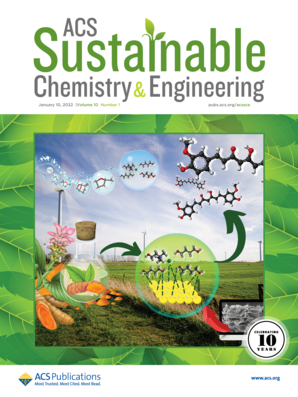Molecular Dynamics Insights of CO2 Capture through Phosphonium-Based Deep Eutectic Solvents for Direct Air Capture
IF 7.1
1区 化学
Q1 CHEMISTRY, MULTIDISCIPLINARY
引用次数: 0
Abstract
Negative emission technologies (NETs) have emerged as a mandatory step to achieve the respective sustainable goals of this generation, and direct air capture (DAC) is the newest addition to this class. Conventional amine- and alkaline-based solvents commonly used for DAC pose various operating disadvantages, and for that reason, deep eutectic solvents (DESs) are seen as a promising sustainable alternative solvent for this purpose. In this study, three DESs based on different compositions of tetrabutylphosphonium bromide (TBPBr) and triethylene glycol (TEG) are computationally studied with the help of molecular dynamics (MD) and density functional theory (DFT). The systems were analyzed based on intermolecular interactions such as radial distribution function, combined distribution function, hydrogen bonds, interaction energy, and diffusion behaviors. The results indicated the ability of the long-chained phosphonium cations to facilitate CO2 molecules in a cage-like structure, whereas TEG molecules proved to be the deciding factor due to their higher polarity. DES2, with a 1:2 molar ratio of TBPBr:TEG showed better structural distribution and affinity toward CO2 overall, which was confirmed with DFT studies. Finally, DES2 was studied under atmospheric conditions (400 ppm of CO2) to confirm the possibility of this solvent being used as a DAC solvent. This showed very promising selectivity for CO2 molecules over nitrogen and oxygen molecules.

通过磷基深共晶溶剂直接空气捕获CO2的分子动力学见解
负排放技术(NETs)已经成为实现这一代各自可持续目标的强制性步骤,而直接空气捕获(DAC)是这类技术的最新成员。通常用于DAC的传统胺基和碱性溶剂存在各种操作缺点,因此,深共晶溶剂(DESs)被视为一种有前途的可持续替代溶剂。本研究利用分子动力学和密度泛函理论对四丁基溴化磷(TBPBr)和三甘醇(TEG)的不同组成进行了计算研究。基于分子间相互作用的径向分布函数、组合分布函数、氢键、相互作用能和扩散行为对体系进行了分析。结果表明,长链磷离子促进CO2分子形成笼状结构的能力,而TEG分子由于其较高的极性而被证明是决定性因素。TBPBr:TEG摩尔比为1:2的DES2总体上表现出更好的结构分布和对CO2的亲和力,DFT研究证实了这一点。最后,在大气条件下(400ppm CO2)对DES2进行了研究,以确定该溶剂用作DAC溶剂的可能性。这表明二氧化碳分子对氮和氧分子的选择性非常有希望。
本文章由计算机程序翻译,如有差异,请以英文原文为准。
求助全文
约1分钟内获得全文
求助全文
来源期刊

ACS Sustainable Chemistry & Engineering
CHEMISTRY, MULTIDISCIPLINARY-ENGINEERING, CHEMICAL
CiteScore
13.80
自引率
4.80%
发文量
1470
审稿时长
1.7 months
期刊介绍:
ACS Sustainable Chemistry & Engineering is a prestigious weekly peer-reviewed scientific journal published by the American Chemical Society. Dedicated to advancing the principles of green chemistry and green engineering, it covers a wide array of research topics including green chemistry, green engineering, biomass, alternative energy, and life cycle assessment.
The journal welcomes submissions in various formats, including Letters, Articles, Features, and Perspectives (Reviews), that address the challenges of sustainability in the chemical enterprise and contribute to the advancement of sustainable practices. Join us in shaping the future of sustainable chemistry and engineering.
 求助内容:
求助内容: 应助结果提醒方式:
应助结果提醒方式:


